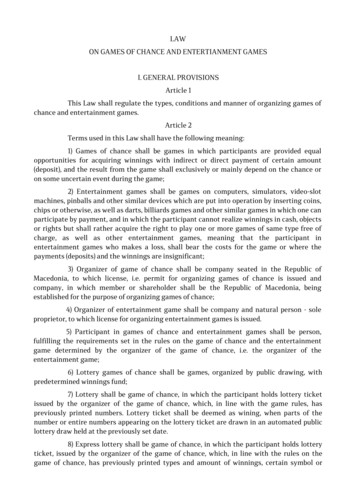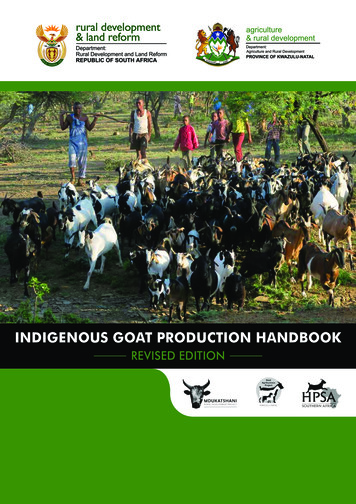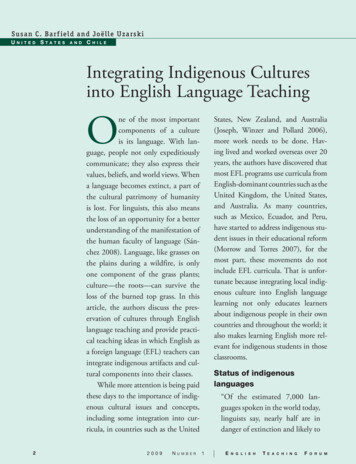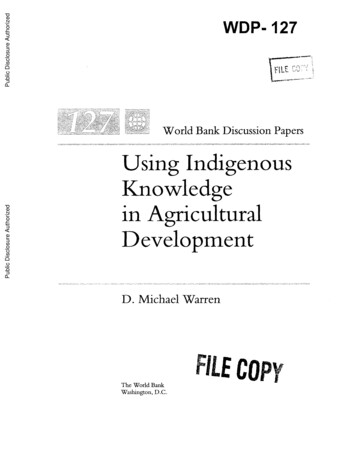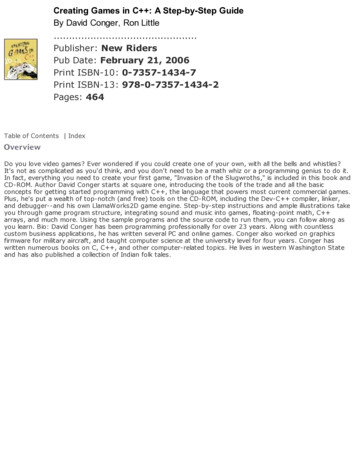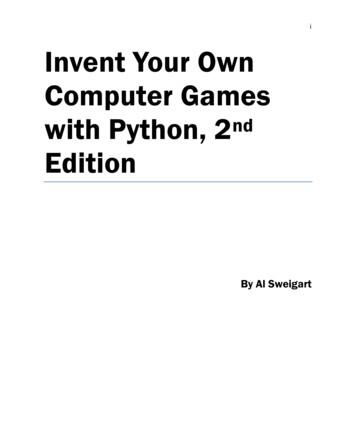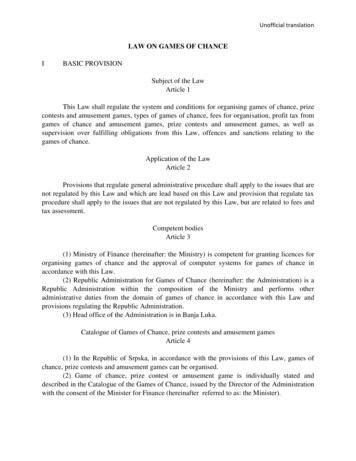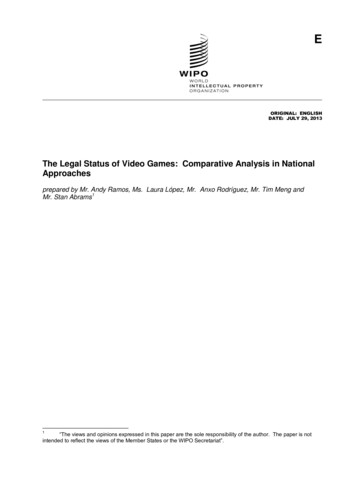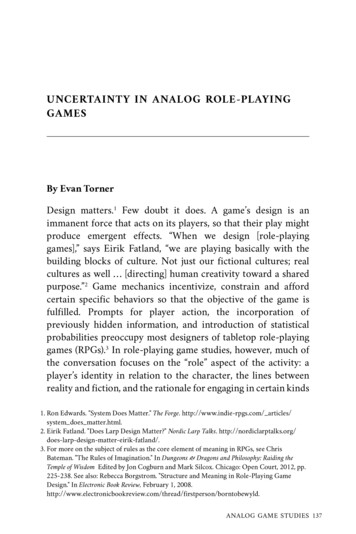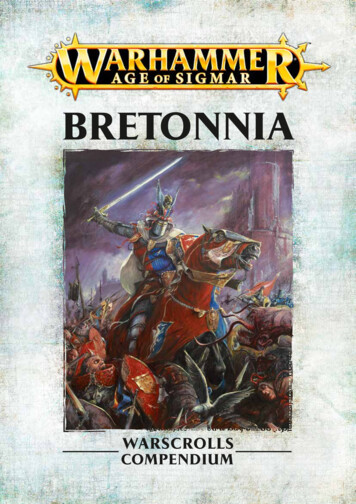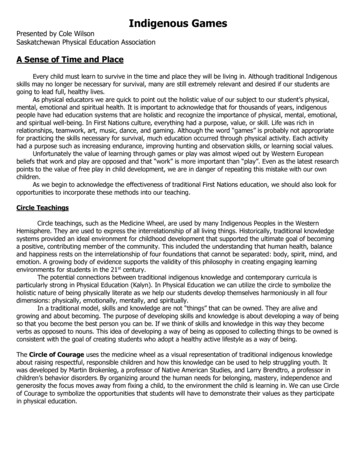
Transcription
Indigenous GamesPresented by Cole WilsonSaskatchewan Physical Education AssociationA Sense of Time and PlaceEvery child must learn to survive in the time and place they will be living in. Although traditional Indigenousskills may no longer be necessary for survival, many are still extremely relevant and desired if our students aregoing to lead full, healthy lives.As physical educators we are quick to point out the holistic value of our subject to our student’s physical,mental, emotional and spiritual health. It is important to acknowledge that for thousands of years, indigenouspeople have had education systems that are holistic and recognize the importance of physical, mental, emotional,and spiritual well-being. In First Nations culture, everything had a purpose, value, or skill. Life was rich inrelationships, teamwork, art, music, dance, and gaming. Although the word “games” is probably not appropriatefor practicing the skills necessary for survival, much education occurred through physical activity. Each activityhad a purpose such as increasing endurance, improving hunting and observation skills, or learning social values.Unfortunately the value of learning through games or play was almost wiped out by Western Europeanbeliefs that work and play are opposed and that “work” is more important than “play”. Even as the latest researchpoints to the value of free play in child development, we are in danger of repeating this mistake with our ownchildren.As we begin to acknowledge the effectiveness of traditional First Nations education, we should also look foropportunities to incorporate these methods into our teaching.Circle TeachingsCircle teachings, such as the Medicine Wheel, are used by many Indigenous Peoples in the WesternHemisphere. They are used to express the interrelationship of all living things. Historically, traditional knowledgesystems provided an ideal environment for childhood development that supported the ultimate goal of becominga positive, contributing member of the community. This included the understanding that human health, balanceand happiness rests on the interrelationship of four foundations that cannot be separated: body, spirit, mind, andemotion. A growing body of evidence supports the validity of this philosophy in creating engaging learningenvironments for students in the 21st century.The potential connections between traditional indigenous knowledge and contemporary curricula isparticularly strong in Physical Education (Kalyn). In Physical Education we can utilize the circle to symbolize theholistic nature of being physically literate as we help our students develop themselves harmoniously in all fourdimensions: physically, emotionally, mentally, and spiritually.In a traditional model, skills and knowledge are not “things” that can be owned. They are alive andgrowing and about becoming. The purpose of developing skills and knowledge is about developing a way of beingso that you become the best person you can be. If we think of skills and knowledge in this way they becomeverbs as opposed to nouns. This idea of developing a way of being as opposed to collecting things to be owned isconsistent with the goal of creating students who adopt a healthy active lifestyle as a way of being.The Circle of Courage uses the medicine wheel as a visual representation of traditional indigenous knowledgeabout raising respectful, responsible children and how this knowledge can be used to help struggling youth. Itwas developed by Martin Brokenleg, a professor of Native American Studies, and Larry Brendtro, a professor inchildren’s behavior disorders. By organizing around the human needs for belonging, mastery, independence andgenerosity the focus moves away from fixing a child, to the environment the child is learning in. We can use Circleof Courage to symbolize the opportunities that students will have to demonstrate their values as they participatein physical education.
The Goals of Physical Education in Saskatchewan: Active Living – enjoy and engage in healthy levels of participation in movement activities tosupport lifelong active living. Skillful Movement- enhance quality of movement by understanding, developing, and transferringmovement concepts, skills, tactics, and strategies. Relationships- balance self through safe and respectful personal, social, cultural, andenvironmental interactions.Placing These Goals in a Traditional Indigenous PerspectivePhysical: First Nations admired persons of superior strength, stamina, or dexterity because they helpedkeep the entire community healthy and strong. It was in the best interests of all to make sure everyonewas as skilled as possible. Long ago, Indigenous games were still played by adults in their forties andfifties.I would argue that it is still in the best interest of our society to have everyone as healthy as possible.To that end we want to develop these physical characteristics in our children so that they becomephysically literate and have the knowledge and confidence to lead a physically active lifestyle as adults.Mental: Success while hunting or during battle would depend on effective use of strategy and tactics.The ability to develop successful strategies and tactics, and recognize and solve problems quickly is stillrelevant to being successful in today’s society.Games of intuition and chance were played by all ages. Even the youngest learned observation, sensing,and intuitive skills to increase awareness of their surroundings. Safety of everyone often dependedupon intuition or extraordinary visioning. With the onslaught of technology and the disconnection fromour natural environment, many children and adults are losing their abilities of keen observation andnatural intuition. Perhaps these skills are just as important in the world today.Spiritual: Spirituality in this context does not pertain to religion. It is simply building and nurturing thepositive relationships that help make a community strong. The social nature of physical education makesit ideal for exploring personal identity and self-awareness and the values and beliefs that determine howstudents will relate to others and their environmentThe social values of traditional games reflect aspects of First Nations culture that I think are worthy ofpromoting in our students. Honor those that gave you the most challenge. Respect the rules of the competition. Respect your competitors. Have courage, intuition, persistence, and patience. Be humble even when winning. Help others be the best they can be Recognize how your environment contributes to your quality of life and respect itWe have to be careful not to assume our students understand these concepts, and make sure we givethem opportunities to experience them and practice them.Emotional: Every task students embark on will have emotions such as joy, frustration, anger, prideattached to them. Physical education is an opportunity to develop the life skills necessary to regulate ouremotions and use them to our advantage.
Games of Stamina and DexterityRING THE STICK - A hoop of any size was tied to a length of rawhide or sinew and attached to astick. The hoop was swung upward and as it came down, the player tried to put the end of the stickthrough the hoop. The ring had to start from a position flat on the ground before being thrown up intothe air. In competition with each other, the players took turns and the player getting the most rings outof an agreed number of turns was the winner. Generally the hoop size was made according to the ageof the players with a large hoop made for the youngest and a smaller hoop and longer stick made forolder children and adults. This was mainly a social game played for fun but develops coordination andmotor skills.RUN AND SCREAM - The children would start running while sucking in a big breath of air; at adesignated mark on the ground, they would start screaming while they were running. When the screamwas finished, the spot was marked with each person’s own marker stick (4 to 6 inch long peg sharpenedto go into the ground). The children would try to pass the other marks. The one who could run thefarthest while screaming was the winner. Traditionally played by girls too old for dolls and too young foradult games, but can be played by all ages of children.MAKE THE STICK JUMP - A favorite game of Blackfoot boys, but can be played by anyone. It was agame of throwing accuracy designed to improve the boys' ability to kill small game birds or rabbits. Astick of 6 to 8 inches was carved and decorated with feathers by young boys. The boys would placetheir sticks at different distances from a line. Numbers or points were awarded to each stick with theclosest stick having the smallest score and the farthest stick given the highest score. The boys wouldstand behind a line then throw a set number of rocks at the sticks. If a rock hit a stick directly, it wouldmake the stick jump and the points for that stick were awarded. The sticks could be laced on theground or stuck into the ground so one end would stand up. Both methods were used.MODERN KICKBALLS – All Indigenous people in North America had some type of kick balls used forracing, hackey sack (foot bag) types of games, and sling ball types of games. Modern Indigenous youthadopted the Zuni and Tewa style of kick bag because, when racing over the prairie, the ball often wouldgo down a ground squirrel hole. The tail on the ball assures a safer way of getting it back out of thehole. Kickball races are won by the person whose ball and body cross the finish line first. Long agoraces could be 10 – 300 miles.Paiute Football: Four players advance down a 50-foot field to place kick their balls between tripodgoals. The ball must pass under one of the three sticks of the tripod first to be the winner. (Ball mustbe advanced without the use of hands)Northern Cheyenne: A race is run by two runners, down the alleyway and back, with the runner whosebody and ball crosses the line first as the winner.Tewa: The contestants lie on their backs holding the tail of the sling ball between their feet and thensling the ball backward overhead. The sling ball going the farthest distance in the air is the winner.Northern Cheyenne: This game is played by one person against another or by one pair against another.The goal is to keep the foot bag up in the air by kicking it to oneself or back and forth betweenpartners. The person or pair that keeps the foot bag up for the greatest number of kicks is the winner.
LINE TAG (Blackfoot) - All playing members make a line holding hands. The idea of the game is forthe first person in line to tag the last person in line. Everyone else tries to help the first person. If theline breaks, the last person goes to the front of the line to become the “tagger.” Every time the lastperson is tagged, they become the “tagger” at the front of the line. The idea of the game is to avoidbeing “tagged” longer than anyone else. The social skills in this game include cooperation, andencouragement. Strength is important as the chasers try to keep the line together and the person beingchased works against the numerical advantage of the chasers.DOUBLE BALL- “When we judge others, it is from our own cultural context.“There is no “right or wrong” way to play double ball, just different ways.”Cree: Double ball was played primarily by women. It was a very rigorous game, demanding top physicalcondition; the goals were placed up to a mile apart.Equipment: A stick about three feet long. Long ago, the double ball was made from two bags of deerskinstuffed with buffalo hair and joined by a leather thong. A dumb bell shaped beanbag or any two smallballs, which can be fastened together, can be used.How to Play:1. The game can be played on a football or soccer field or on any area where the goals are at least100 yards apart.2. There can be from four to eight players on a team.3. The game is similar to lacrosse, except the ball is only moved by throwing it with the stick. Itcannot be touched with the hands or feet.4. The game begins with one player throwing the ball toward center field. The ball, once caught bya player, cannot be carried on the stick. It must be passed from one player to another.5. Players can try to hook the ball by knocking it off their opponent's stick.6. The team that throws the ball across the goal line wins the game.Blackfoot: According to Richard Horn, a Blackfoot traditional games teacher, often a woman would call adouble ball game whose husband was not treating her well. The women would come together for atough game to show the men their power and strength. The men would watch and tease the manwhose wife called the game together. It was said the man usually treated his wife better after that.Assiniboine: Originated from using a portion of the entrails of the harvested buffalo and flinging it with astick into the “goal.” Harvesting buffalo was always hard, but happy work and the game evolved fromthe play of young women who didn’t want to touch the parts of the buffalo.A target was set at each end of a play area and teams formed spontaneously. The game was informal,without rules, but important in bringing the community together. This is important because it isrecorded that the split between the Assiniboine from the rest of the Sioux resulted from a dispute overpossession of buffalo. The story of great buffalo harvests remains through stories of elders and gameslike this. (Credit to Tim Eashappie – ECUR 352)HOOP AND ARROW - The earth begins to awaken in March. Winter supplies of food were low at thistime of the year and the men had to travel in search of large game. The youth were taught the hoopand arrow games to become skillful at bringing down small game for the community while the men weregone. The hoop and arrow games taught honesty through, “truth in scoring,” and skills necessary forhunting as a means of survival.
Pend d’Orielle Hoop & Arrow game: A long pole is laid on the ground about fifteen feet from theplayers. A non-player rolls the ring so it will hit the pole and fall down. The two players throw theirarrows toward the place where they think the ring, after it hits the pole, will fall on an arrow, therebyawarding them the number of points as assigned to the color of the beads touching the arrow. The sixbeads are of different color and represent different points as agreed upon by the players before startingthe game. Players seek the highest number of points per round for a win. Points may be addedtogether for a team vs. team game.Salish Hoop & Dart game: Six players from each team line the opposite sides of a30’ long x 10’ wide alleyway and attempt to throw their dart through a netted hoop that is thrown to rolldown the alleyway. Players toss their darts at the rolling hoop in an attempt to slow it and make it fallon their own dart. The dart must be in the netting in order to score points. Points are awarded by 1one for anywhere in the netting and 3 for the center hole in the netting. The team gains points byadding individual scores together. The team with the most points by the end of the playing time willwin.Crow: “A-ba-tsink’-i-sha”: is a netted hoop game played with two darts that have trident ends. Thegame is played by rolling a hoop toward an end log as two players attempt to throw a dart through thenetted hoop center. If the dart passes into the net and stays as the hoop falls, thereby trapping thedart, a score of one point is given. The game is played until a certain score is achieved or one playergets a “bulls’ eye,” (kills the bull).“Painyanka ichute” Yankton Sioux Fort Peck. Painyanka means, “Shooting the Buffalo.” The game isplayed with two players representing two sides, who throw one set of sticks each at the hoop as it rollspast. When the hoop falls, hopefully on the sticks, the scores are counted. The hoop represents agathering of all Sioux Nations, and in past days, the chief’s family could locate all bands upon the hoop.The hoop also represented the rim of the horizon and the four quarters of the earth. The spaces markthe openings or passes into the circle of the gathering. They also represent the four winds and areinvoked as such by the thrower before he throws.STICKS - Each team places sticks (pool noodles) in their territory. Once the hoops have been placed,they may only be touched by members of the opposite team. The objective is to capture all the hoops.This means you must sneak into the other team’s territory to capture their hoops while also protectingyour own hoops. If you are captured in the other team’s territory you must sit and wait to be rescued by ateammate, who may safely walk you back to your side while holding your hand. You are safe if standing in another teams hoop and the hoop is on the ground. If you get captured while holding a hoop you must put the hoop down (it remains there). Youmay not take it with you when you are rescued.Once you place a captured hoop in your territory it may no longer be moved by anyone on your team.FEATHER DARTS: materials - various turkey feathers, string, and target.Background info - this is start of acquiring skill to hit a moving target. The target is hung on a string.The player holds a feather and stands beside the target. The player takes 2 natural walking stridesaway. 2 natural strides their body length. Then, the player will turn and throw the feather dartat target. Each player gets a second shot. The second shot has to be done with other hand. The reasonis so they can develop ambidextrous skills. Once players are able to hit the target, then take a couplemore strides away. If they are successful, then pendulum swing the target and then let the playersattempt to hit the target while it is in motion. Players must use both hands.
WHIPPING TOPS -This game was usually played on ice, and teams of at least two boys played it.Each team had a top and each boy had a whip; a stick with a piece of rawhide attached to one end. Ateam kept the top spinning by whipping it. The team whose top keeps spinning the longest wins or thetop could be made to race along a path towards a finish line.STICK PULL GAME - was used to help strengthen the hands and wrist of the Dene and prepare themfor the fishing season. Often large fish swam along the shores and rivers enabling the Dene easyaccess. They would simply reach down and grab the fish near the middle of its back and throw it up onthe land or shoreline. Though it may sound easy, the ability to grab a 20-pound whitefish or anaggressive Pike out of the water and toss it up on the shore required quickness, eye-hand coordinationand incredible wrist and finger strength. Fish are often very slippery to hold and being able to grab aheavy fish out of the water is very difficult. So in order to remain strong and able Dene men wouldchallenge each other in a stick pull. The stick is approximately 25 centimeters (12 inches) long, with a center diameter of 2.5centimeters (1 inch) The stick has to be greased with Crisco oil or lard to create a very slippery surface. Opponents will stand with feet shoulder width apart and the right foot of one participant willtouch the right foot of the other participant. On the signal, “Ready, Pull”, the opponents to try and pull the stick out of each other’s hand.Students cannot jerk or twist the stick or bend the arm during the stick pull. Students are notallowed to lean forward or to the side. There are two ways to win the game, a student must be able to pull the stick back beyondhis/her waist (or hip) and hold the stick in this position for a 2 second count or he/she can pullthe stick out of the other student’s hand. (Credit to Roxanne Noltcho Sylvester – ECUR 352)CORRALING THE BUFFALLO (Cree) - Long before the arrival of the horse, the First Nations people hadto devise a method to capture the buffalo. Many of the Plains people developed corrals or they wouldstampede the herds over cliffs if any were nearby. All the Nations from the Cree south to the Sioux inthe United States adopted this method. As the plains were usually vast sprawling expanses of flat land,the Cree were the masters of building corrals in order to herd the buffalo in. The children were taughtthe importance of a successful hunt and they often played this game early on in life as this enabledthem to hone their skills at capturing the buffalo later in life. One famous chief of the Plains Cree,Poundmaker took the name of his grandfather, who was an expert at building these contraptions. Justlike his grandfather, Poundmaker was a renowned buffalo pound maker and that is where his name isderived from. Since there were no horses available until the Europeans arrived, the people who wereable to build these corrals were held in high esteem because the survival of the community dependedon the ability of the corrals to keep the stampeding buffalo in the corral. Once the animals were in thepens, they were then butchered and this ensured the survival of the people as everything they used andneeded essentially came from the buffalo.In closing, this game was used by the Cree in the northern and southern plains of Saskatchewan. Thechildren were taught to play this game and the idea and importance of the community’s survival hingedon their ability to work together as a team and this idea was carried on through the rest of their huntinglives.There will be two teams of 6 hunters to a team and one buffalo and the boundaries of the prairie will bemarked off. The team will have 3 minutes to try and corral the prey without the hunter and prey touchingeach other, much like the game of tag. The team that can successfully herd their prey will get 5 pointsand if the prey can successfully dodge his opponents will get 5 points. After time has elapsed, the otherteam will have a chance to chase the prey. (Credit to Conrad Martell – ECUR 352)
TANTANKA TATANKA – (Tatanka is the leader of the buffalo) Tatanka, Tatanka comes from theDakota people. It is a game that is usually played by women and small children; they would mimic theirfathers and grandfathers who used to go on the buffalo hunt. The game helped the women andchildren learn how to lead the buffalo into the compound during the hunt. The game is aimed atyounger kids so they can learn these skills early on and be experts when it was their time to go on thehunt.The only equipment needed then was a Tatanka head; they would most likely be playing in achosen open area or the buffalo compound. There were no prizes as the game was for fun and to learnsurvival skills.During the buffalo hunt everyone who as able bodied to help would do so. This game taught thewomen and children how to help out when they needed to. It also taught them the basics of chasing,running, and fleeing.This game would be played in the spring and summer before the big buffalo hunt so they wouldbe prepared to help out when the time came. The game was taught so women and children were ableto do their part during the buffalo hunt. Everyone needed to take part in this hunt because it was sucha big task and their survival depended on the buffalo. The fleeing, running, and chasing were importantbecause they would be leading buffalo that were most likely stampeding and if they couldn’t run awaywhen they needed to then they could be injured.Rules:One student is chosen as the Tatanka and the rest of the student’s line up against the wall. TheTatanka calls out “Tatanka, Tatanka” and the students run across to the other side of the gym and trynot to get tagged by the Tatanka. If a student is tagged they become part of the Tatanka’s herd andhave to try tag more students to become part of the herd. When there are no more runners the gameis over and new Tatanka is chosen. (Credit to Rachel Thomas, Janice Apesis, and Tim Eashappie – ECUR352)Games of Intuition and ChanceSTICKS IN THE FIST-This game of pure intuition and chance is played with ten sticks, cut to fit in afist. One stick is marked on the bottom. This game of probability encourages the player to "sense" thestick which is marked, and to draw as many unmarked sticks as possible before drawing the markedstick. Drawing nine unmarked sticks with the marked as last draw, is the highest honor. Playing withthe set of sticks more than once, gives the player a greater chance of using "observation" instead of"sensing" to win the game. Both skills are admired.THE TIE UP GAME (Inuit & Turtle Mt. Chippewa) - In the traditional culture of some Indigenouspeoples, there was a way of making young people learn to work together. If two young people werefighting or arguing, an uncle or aunt would often tie the two together in a way that cooperationbetween the two had to occur or they would not be able to get out of the tie-up. In this game, the twowould be loosely connected by one rope passing over the other person’s rope with both ends of eachrope simply holding each wrist with a slipknot. The two players are told that they must work togetherto become separated from each other “without taking the slip knots off their wrists.” After muchencouragement to keep trying or after both players are talking to one another and cooperating with oneanother, the children could be released without telling them the solution. The social skills are sharing,cooperating, and conflict resolving.
PLUM STONE - Teams of 1-10 players face each other leaving space of 3 feet.Put counting sticks on the ground between teams and the plum stones, or cut antler buttons in abasket. Each team has one person toss; high score starts. Players on the first team keep basket, taking turns, until a stone lands on the ground or a “noscore” is tossed. Object of the game is to get all the sticks.222211moons, 3 white 3 sticksstars, 3 whites 3 sticksmoons, 3 black 2 sticksstars, 3 black 2 sticksstar, 1moon, 3 white 1 stickstar, 1 moon, 3 black 1 stickGUESSING THE STICK - ”How many sticks" was a guessing game to test perception, intuition, andobservation, played quietly by the children as the adults played their hand games. Any number of smallstraight sticks were gathered (at least 20) and put into a bundle to be held by one person. The bundlewas divided and held in each hand then quickly shown to two other players who looked at the bundlesbefore they were hidden or guessed. The object of the game was to estimate how many sticks were ineach bundle. The one whose guess was exactly right was the winner. The winner of the guess is givenone of the counting pegs. The winner of the game is when one person accumulates all three countingpegs. A GAME FOR ALL AGESLONGBALL (Eastern Woodlands)Equipment:Baseball bat Soft ball the size of a normal baseball (safe to throw at a person) 2 - 9.15 meters (30ft)ropes or chalked lines.Playing FieldThe playing field should be approximately 15-23 meters (50-75 feet) long and with no width boundaries.The Finish & Start line is placed at one end with the safe line parallel to it but 15-23 meters (50-75 feet)away.
Gameplay Divide the players into two teams. Select a pitcher, an umpire and a catcher (an adult or neutral player’s) for the entire game. Outfield Team - has no assigned positions, should be scattered between the start/finish line and thesafe line. No outfield player can be positioned behind the two lines. Batting Team - selects a batter who will be the batter for the entire time this team is up to bat. Batterdoes not run. The batter has 3 good pitches to hit the ball (the umpire and pitcher decides if it is agood pitch). Fouls - no foul balls except behind the start/finish line. If the batter misses three good pitches this iscounted as an out. Three outs are required before the teams switch positions. Batting Team - Runners are the remaining players from this team. They are positioned along eachside of the batter who is in the middle of the start/finish line. Hitting the BalloooooRunners: once the ball is hit into the fair ground, the runners run toward the safe line and backif possible. Runners can no longer be called out or hit once they cross the safe line. At least onerunner must make it to the safe line and back to the start/finish line after each hit.Outfield: the outfield team must catch the ball to get an out or they can throw the ball at theopposing team below the waist. If a ball throw goes above the waist it will count as a point forthe opposing team.Outs: Three outs are required to switch team positions. The outfield team can try to get threeouts on one hit.Points Scored: A point is scored every time a runner makes it from the start line to the safeline and back to the finish line. If the hit is good the runners can continue to run back and forthfrom each line as many times as possible, until an out is made. Note: remember that at leastone runner must make it from start line to the safe line and back each time the ball is hit. Thefinal score can get high into the 100’s, thus scorekeepers are required.Innings: Three innings are played because the score increases quickly.ResourcesInternational Traditional Games Society (http://www.traditionalnativegames.org/)Saskatoon Public School Division; First Nations, Inuit & Métis Education UnitGames researched and presented by students in ECUR 352-29, Methods in Elementary PhysicalEducationCullen, Stewart. Games of the North American u/mvac/knowledge/NAGames.htm
/treptau1/ReadingBrendtro, K., Brokenleg, M., Van Bockem, S. (2005). The Circle of Courage and Positive Psychology,Reclaiming Children and Youth 14, (3), 130–136.Robinson, D., Lunney, L., Robinson, I. (2013) Charting a Course for Culturally ResponsivePhysical Education. Alberta Journal of Educational Research, 58, (4) 542-546.Halas, J. (2002). Engaging troubled youth in physical education: An al
MAKE THE STICK JUMP - A favorite game of Blackfoot boys, but can be played by anyone. It was a game of throwing accuracy designed to improve the boys' ability to kill small game birds or rabbits. A stick of 6 to 8 inches was carved and decorated with feathers by young boys. The boys wou
